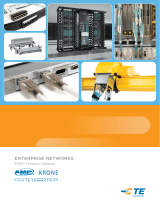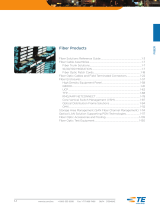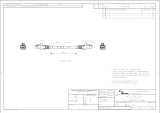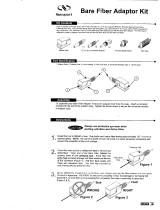Page is loading ...

Instruction Sheet
LightCrimp* Plus LC
408--10103
LOC B
1 of 6
E2009 Tyco Electronics Corporation, Harrisburg, PA
All International Rights Reserved
TE logo and Tyco Electronics are trademarks.
*Trademark. Other products, logos, and company names used are the property of their respective owners.
TOOLING ASSISTANCE CENTER 1--800--722--1111
PRODUCT INFORMATION 1--800--522--6752
This controlled document is subject to change.
For latest revision and Regional Customer Service,
visit our website at www.tycoelectronics.com
18 AUG 09 Rev E(for Jacketed Cable) C onnectors
Boot
Crimp Eyelet
Rear Protective
Cap
Connector Assembly
Termination
CoverG
Duplex
Clip
G Connector kit is shipped with these installed onto the connector
assembly. Keep them in place until ready for use.
Figure 1
1. INTRODUCTION
This instruction sheet describes the installation of
LightCrimp Plus LC Connectors (Figure 1) to 2.0--mm
loose--jacketed, 900 μm--buffered fiber .
Please read these instructions thoroughly before
starting terminations.
Reasons for revision can be found in Section 7,
REVISION SUMMARY.
2. DESCRIPTION
Each LightCrimp Plus LC Connector consists of a
termination cover , a rear protective cap, the main
connector assembly, the crimp eyelet, and the boot.
RefertoFigure1toseetheseitems.
3. SAFETY PRECAUTIONS
To avoid personal injury, ALWAYS wear eye
protection when working with optical fibers.
NEVER look into the end of terminated or
unterminated fibers. Laser radiation is invisible
but can damage eye tissue. NEVER eat, drink, or
smoke when working with fibers. This could lead
to ingestion of glass particles.
Be very careful to dispose of fiber ends properly.
The fibers create slivers that can easily puncture
the skin and cause irritation.
DO NOT use damaged tools. Replace them with
new components.
4. REQUIRED TOOLS AND MATERIALS FOR
ASSEMBLY
Related instruction sheets are listed in
parenthesis.
S Micro--Strip Tool 492109--3 -- 0.008 in.
S Combination Strip Tool 1278947--1 (408--4577)
S Cable Holder Assembly 2064540--1 (Used only
to terminate connector with cover installed.)
S LightCrimp Plus LC, SC, and Splice Die Set
with Crimping Tool 2064603--1 (consists of Die
Set 1985766--1 and LightCrimp Termination
Handle ---- PRO--CRIMPER III Hand Tool ----
2064431--1)
S Cleave Tool 1871696--1 (408--10086)
S Fiber Optic Inspection Microscope Kit
1754767--1
S Microscope Adapter , 1.25 mm Ferrule
1754765--1
S Open Ended Wrenches 1278422--1
S Cable Slitting Tool 2064453--2
S Alcohol Wipe Packet 501857--2
S Reagent--grade isopropyl alcohol and lint--free
cloths
S Shears (KEVLAR cutting) 1278637--1
S Cable Clamp 1278625--1
Termination tools can be found in kits 1754845--1
and 1754845--2.
5. ASSEMBLY
5.1. Preparing the Fiber
1. Slide the boot over the jacket as shown in
Figure 2. Place a clamp approximately 200 mm
[8 in.] from the end of the cable ---- behind the boot
(depending on the type of cable used).
DANGER
DANGER
CAUTION
!
NOTE
i
NOTE
i

408- 10103
LightCrimp Plus LC Connectors
Rev E2 of 6 Tyco Electronics Corporation
Figure 2
2. Place the cable into the cable channel on the
cable holder and mark it at the first and second
slots as shown in Figure 3.
Important: When terminating to zip cord cable,
be sure to mark both strands at the same time.
This is required to assure maximum cable
retention performance.
Figure 3
Mark the Cable
3. Use the combination strip tool to cut the jacket
at the first mark from the cable edge and remove
thejacket.SeeFigure4.
Figure 4
4. Use shears to cut the strength members flush
with the jacket. See Figure 5.
Figure 5
5. Slide the cable into the slitting tool until the
second mark is aligned with the blades as shown in
Figure 6. Squeeze the handles and pull to slit the
jacket.
Figure 6
6. Fan back the jacket and strength members.
7. Slide the eyelet over the strength members as
shown in Figure 7.
Figure 7
8. Place the buffer on the buffer channel of the
cable holder. Mark the buffer at the two slots as
shown in Figure 8.
NOTE
i

408- 10103
LightCrimp Plus LC Connectors
3 of 6Rev E Tyco Electronics Corporation
Figure 8
Mark the Buffer
9. Use the combination strip tool to strip the buffer
to the first mark. You should strip it in smaller
sections multiple times.
10. Use a lint--free cloth (dampened with alcohol)
to clean the the fiber and remove any residue.
Wipe AWAY
from the buffer. If the fiber breaks, cut
the buffer flush with the jacket and begin the “strip”
process again, beginning with Step 2 in Section
5.1.
Multiple wipes will ensure cleanliness and also
trensile tests the fiber.
Do not lay cable down! Going directly to the next
step will prevent the cleaned fiber from
becoming contaminated.
Figure 9
5.2. Cleaving
1. Open the fiber clamp of the fiber optic cleaver .
Press the button, and slide the carriage back
(toward the fiber clamp). Then move the fiber slide
back until it stops.
2. Place the stripped buffer into the slot so that the
end of the fiber is at the 8--mm marking. See
Figure 10.
Figure 10
8mm
3. While applying pressure on the fiber, carefully
slide the fiber slide forward (toward the carriage)
until it stops. See Figure 11.
Figure 11
4. Gently close the fiber clamp and swiftly slide the
carriage forward. DO NOT touch the button while
sliding the carriage. See Figure 12.
Figure 12
Do not touch or attempt to clean the fiber after
the cleave has been made.
5. Open the fiber clamp and move the fiber slide
back until it stops.
NOTE
i
CAUTION
!
CAUTION
!

408- 10103
LightCrimp Plus LC Connectors
Rev E4 of 6 Tyco Electronics Corporation
6. Remove the cleaved fiber and properly dispose
of the scrap fiber .
5.3. Crimping
1. Place the connector in the holder as shown in
Figure 13.
Figure 13
2. Clamp the jacket with the tip of the fiber
positioned at the back edge of the holder.
3. Carefully insert the fiber into the back of the
connector until the fiber bottoms against the
internal fiber . Make sure that the remaining mark
on the buffer enters the plunger
It is VERY IMPORTANT that the prepared fiber
bottoms and stays against the internal fiber! If
the remaining mark does not enter the plunger or
if the fiber does not seem to bottom against the
internal fiber, gently pull back and re--insert the
fiber into the plunger until you feel it bottom.
If the remaining mark will not enter the plunger,
the fiber must be re--stripped.
4. Slowly squeeze the tool handles together until
the ratchet releases. Allow the handles to open
fully. Slowly close the handles until you hear two
clicks from the ratchet.
5. With the connector assembly in the cable
holder, position the termination cover in the upper
cavity of the front die and the knurled rear body in
the upper cavity of the rear die. See Figure 14.
The arrows marked on the front die indicate the
direction that the termination cover must be
pointing when the connector is positioned in that
cavity. For proper placement, and to avoid
damage to the fiber, observe the direction of the
arrows.
Figure 14
6. Gently push the buffer toward the connector
assembly to make sure that the fiber is still
bottomed, then slowly squeeze the tool handles
together with both hands until the ratchet releases.
Allow the handles to open fully, and remove the
connector from the dies. See Figure 15.
Figure 15
7. Position the back of the connector assembly in
the cavity of the front die with the knurl against the
edge of the groove in the die and the termination
cover pointing in the direction of the arrow.
8. Slowly squeeze the tool handles together until
the ratchet releases. Allow the handles to open
fully, and remove the connector assembly from the
die. See Figure 16.
9. Pull back the eyelet and fan out the jacket and
strength members over the connector knurled
body. See Figure 17.
NOTE
i
CAUTION
!

408- 10103
LightCrimp Plus LC Connectors
5 of 6Rev E Tyco Electronics Corporation
Figure 16
(Shown While Perfoming the Crimp)
(Shown After the Crimp) is Complete
Figure 17
10. Push the eyelet over the jacket and strength
members. The KEVLAR strength members and
jacket should protrude as shown in Figure 18
Excess KEVLAR fiber and jacket may be
trimmed with a shears (1278637--1), if desired.
Figure 18
11. Position the connector in the die (as shown in
Figure 19) and squeeze the tool handles.
12. Unclamp the jacket and slide the boot onto the
back of the connector . See Figure 20.
Figure 19
Figure 20
The finished termination should appear as shown
in Figure 21.
Figure 21
Inspect the finished connector before
terminating.
NOTE
i

408- 10103
LightCrimp Plus LC Connectors
Rev E6 of 6 Tyco Electronics Corporation
DANGER: Never View Active Fiber Signals
6. AVAILABLE AIDS
S Professional Fiber Optic Connector Inspection
Kit 2064651--[ ] (Instruction Sheet 408--10263)
S Fiber Optic Cleaning and Inspection Guide
2064710--1 (on compact disc)
More information can be found at:
---- www.ampneconnect.com/foguide
;or
---- www.tycoelectronics.com/documents
.
7. REVISION SUMMARY
S Removed alternate termination method;
S RemovedtableinFigure1
S Updated format to current corporate
requirements
/












